Science
LISA will be sensitive to gravitational waves with a frequency of 0.1 to 100 milliHertz. This is unchartered territory because current detectors on Earth—such as LIGO and Virgo—can only measure frequencies between 10 and 10,000 Hertz. It allows LISA to be the first to hear collisions of supermassive black holes, with each other and with stars.
Also gravitational waves from the distant Universe have low frequencies, because their wavelengths are stretched out on their long journey through the ever expanding Universe. So LISA will also be the first to perform measurements on the period shortly after the Big Bang, when the Universe probably was expanding at unprecedented speeds. Moreover, astronomers hope to see the first seeds of supermassive black holes in the ‘dark ages’, during the Universe’s first hundreds of millions of years. The (run-ups to) collisions of compact binary systems in our Milky Way are within LISA’s reach too, both of binary black holes as well as of other types of compact binaries.

Credit: NASA GSFC
Astrophysics
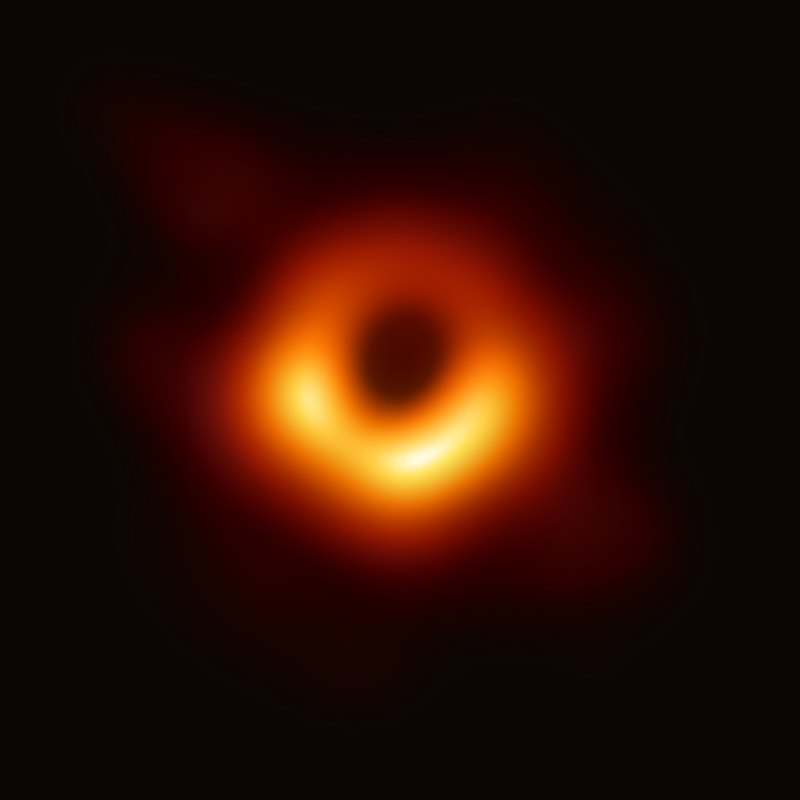
The first ever image of a black hole. This is the supermassive black hole in the center of the galaxy M87. Credit: Event Horizon Telescope Collaboration
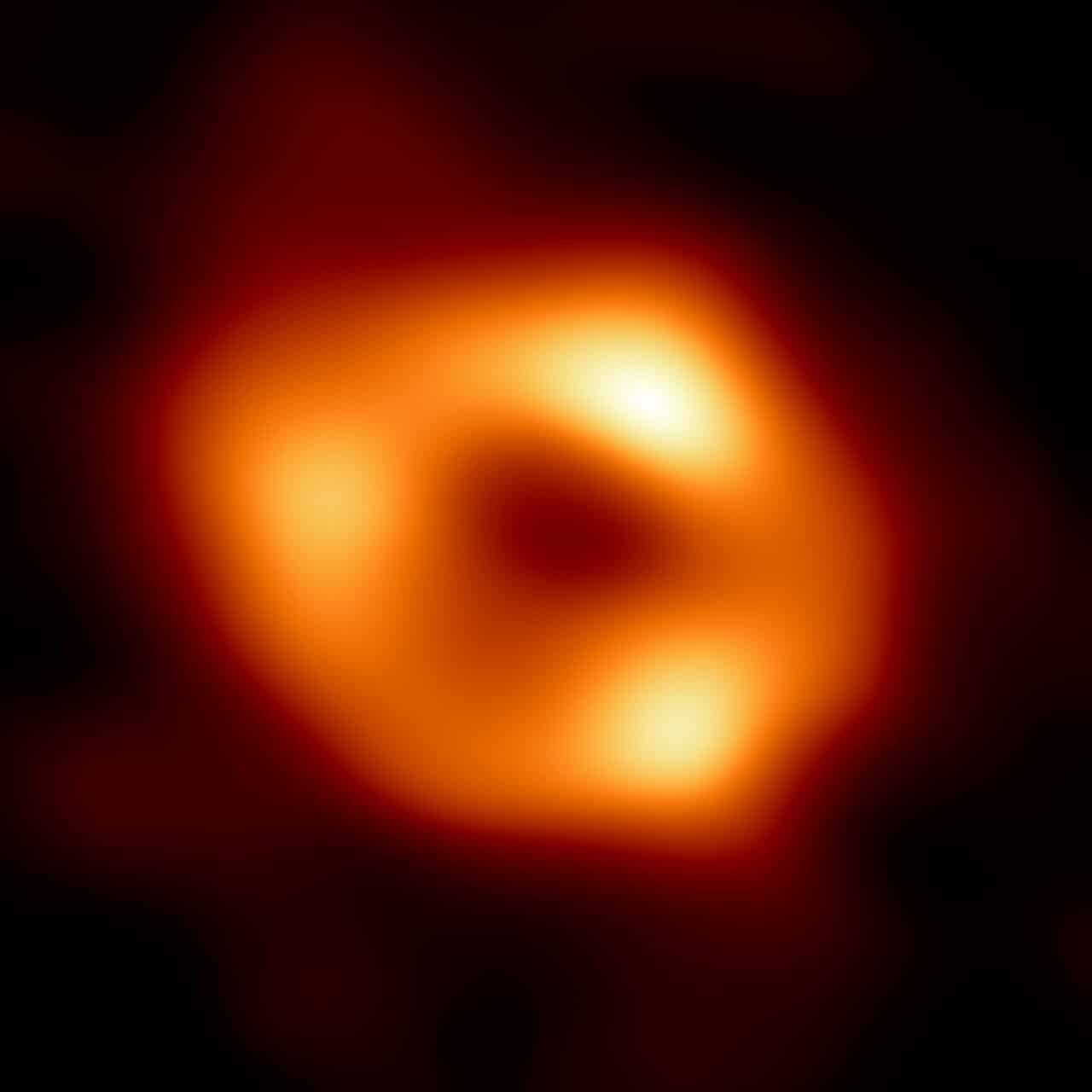
The supermassive black hole in the center of our Milky Way galaxy: Sagittarius A*. Credit: Event Horizon Telescope Collaboration
Black holes
In the hunt for black holes, conventional telescopes often face two hurdles. We can only discover black holes if they steal material away from a companion star, thereby emitting (X-ray) radiation. And then there are dust clouds in the Milky Way disk that could obscure our view. These hurdles mean that conventional telescopes have only observed black holes with a relatively low mass of under twenty solar masses. After all, more massive black holes are stuck in the Milky Way disk and originate from such large stars that their companions are often too far away to steal from.
Astronomers have long been misled by this biased census. When in 2015 LIGO detected a gravitational wave for the first time, it immediately became apparent that our picture of the black hole population was way off. LIGO heard two black holes of respectively 36 and 29 solar masses colliding. It shows that gravitational wave detectors are immune to inactivity or dust clouds. With its frequency range, LISA will be able to detect all (run-ups to) collisions between black holes, in order to perform a reliable census of black holes in our Milky Way, both in terms of mass and spin. This allows astronomers to map the evolution of black holes; how fast they grow and how they feed themselves.
Most black holes originate from dying stars and often weigh no more than tens of solar masses. We call those ‘stellar black holes’. But some are a lot more massive, up to billions of solar masses. Famous examples of these ‘supermassive black holes’ are the one in the center of our Milky Way and the one in galaxy M87, whose shadow was captured on camera for the first time in 2019, see the image above. Astronomers expect to find the seeds of supermassive black holes in the first hundreds of millions of years after the Big Bang. During these dark ages there were hardly any stars to illuminate the world, but baby black holes were probably already lurking in the dark. They could just be ordinary stellar black holes, but according to our theoretical models those would need more time to grow into the monsters we see today than the time frame between then and now. So we might as well discover something completely new. LISA will listen to the mass and spin of the seeds and the wavelength of their gravitational waves. By doing the same for the more evolved ones in later stages of the Universe, we gain a complete picture of the evolution of supermassive black holes.
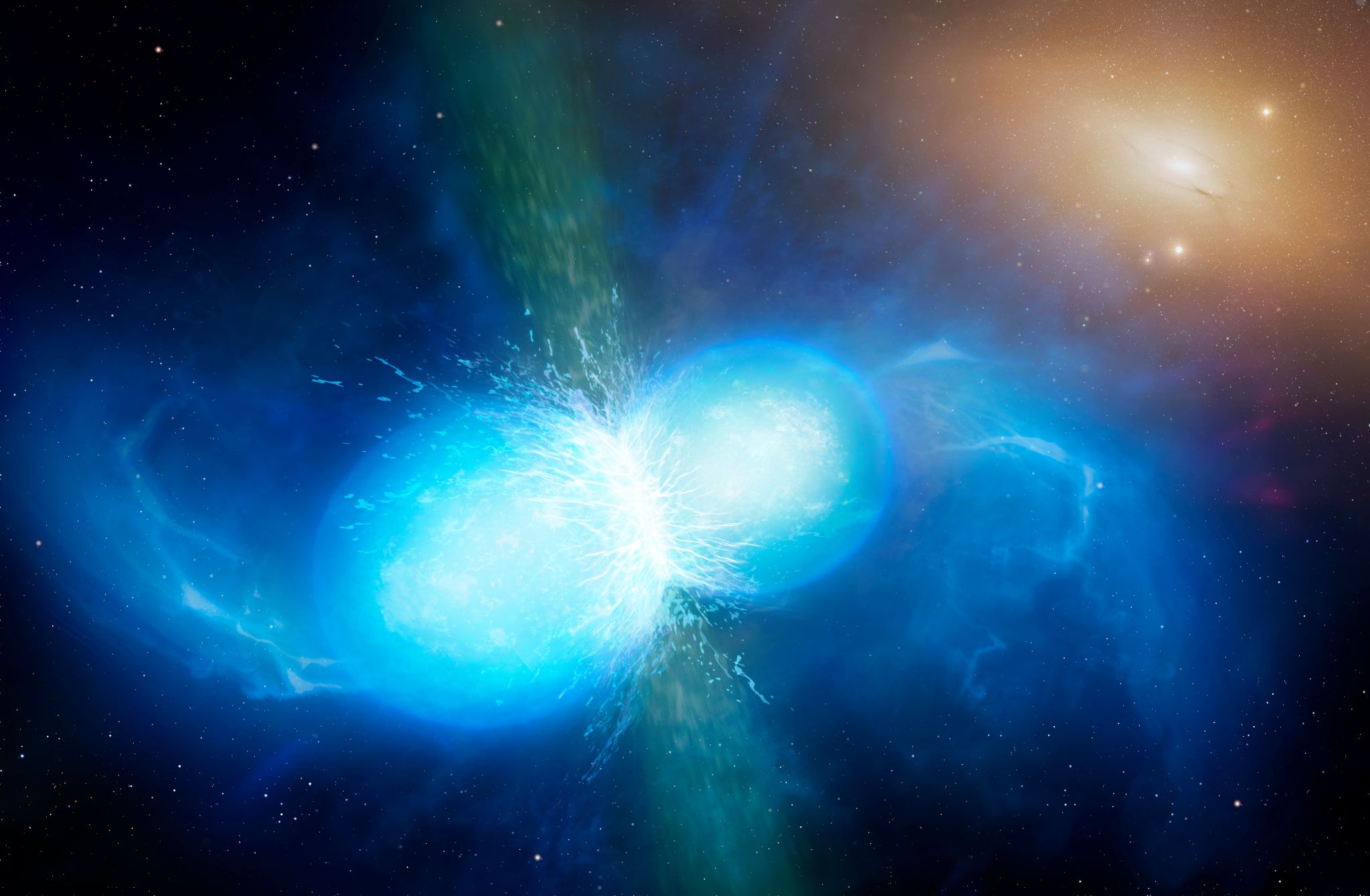
Artist impression of two neutron stars in a binary system. Gravitational waves are created during an eventual collision. Credit: University of Warwick/Mark Garlick
Binary star systems
Aside from pairs of black holes, there are other binary systems that emit gravitational waves, such as all combinations of so-called compact objects: neutron stars, white dwarfs and stellar black holes. LISA will map their distribution within our Milky Way; inside its thin disk, thick disk, halo and globular clusters. This provides information on the formation and evolution of binary systems.
The interesting thing about binary systems with at least one regular star is the mutual transfer of matter that takes place prior to a collision. LISA will listen to this process, which is fairly unknown. LISA will focus in particular on binary systems with one compact object and one supermassive black hole. Because supermassive black holes are in the center of a galaxy, they help us estimating the number of each type of compact object there.
Cosmology
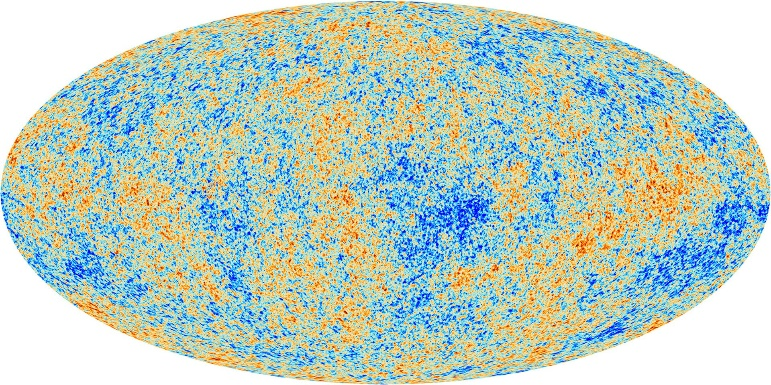
Credit: ESA; Planck Collaboration
Primordial gravitational waves
During the first epoch following the Big Bang, it was impossible for photons to travel through the Universe undisturbed. Electrons were not yet bound to atomic nuclei, so they roamed around freely, making up a dense fog. This fog remained for 380,000 years, until the Universe had cooled down enough to lose its ability to counterbalance the attractive force between electrons and atomic nuclei. This is when the fog cleared and photons could travel in a straight line. Most photons from that time have yet to encounter something to obstruct their way and have been going straight ahead to this very day. This so-called cosmic microwave background is coming at us from all directions. And no matter in which direction we point our telescopes, this microwave radiation is the farthest we can see. Behind it we will always encounter a dense electron fog.
Fortunately, we can hear just fine in a fog bank. And that is exactly what LISA will do. The Big Bang comprises the mass of the entire Universe, so obviously this is accompanied by strong gravitational waves. And those have no problem whatsoever to travel from the Big Bang towards the present, straight through the electron fog. In 2014, astronomers thought for a moment that they saw a trace of it even without gravitational wave detectors. Using a conventional telescope they looked for the effects of primordial gravitational waves in the cosmic microwave background, thought they saw them, but it soon turned out that Milky Way dust had caused the effects. In 2015 the ground-based detector LIGO was the first to hear a real gravitational wave. But ground-based detectors are not susceptible to the long wavelengths of primordial black holes. LISA however is within the correct range due to its long arms.
Inflation
Through primordial gravitational waves, astronomers hope to use LISA to find evidence of the Universe’s extreme expansion right after the Big Bang: within 10-32 seconds the Universe grew by a factor of 1026. Two of the greatest mysteries in astrophysics can be solved with this inflation hypothesis. Why are galaxies so similar even though they are so far apart that they couldn’t have been in contact with each other? And isn’t it too much of a coincidence that the Universe has exactly the flat geometry in which stars and planets can form? A rapid expansion at the very start would mean that before, all galaxy seeds were tightly packed together, close enough to influence each other. And inflation leads to a situation where the density of all matter and energy in the observable universe is by definition very similar to the ‘critical density’—the density at which the Universe is flat.
Fundamental physics

Hubble Ultra Deep Field. At the large scale, all galaxies are moving away from each other at an accelerated speed. Astronomers are unsure about the driving force behind this, so they give it the working title "dark energy". Credit: NASA/ESA
Dark energy and dark matter
Since 1998, we have known that the Universe’s expansion is accelerating. But during the two decades that followed we have not managed to figure out what is causing this acceleration which is defying all laws of gravity. Astronomers therefore use the mysterious term ‘dark energy’. We see the opposite happening on a smaller scale. Galaxies seem to exert a stronger gravitational pull on their outer regions than what we expect based on the galaxy’s stellar mass. The outermost stars are orbiting around the center of their galaxy so fast that they should actually fly off the rails according to the physics we know. The mysterious matter that must be hidden somewhere within galaxies is termed ‘dark matter’.
Dark energy and dark matter, together with regular matter, shape the Universe. They determine whether the geometry of space is flat, closed or open. And they decide our fate: will the expansion always keep accelerating, will the Universe eventually shrink or is there an intermediate scenario in which everything keeps flying apart, but at an increasingly slower rate? From the cosmic microwave background and galaxy velocities we can already create a decent model of the amount of dark energy, dark matter and regular matter at different times in the Universe’s history. That calculation indicates that all three together add up to exactly the right amount for a flat Universe. Now perhaps you would expect that this geometry leads to a fate according to the intermediate scenario, with an increasingly slower expansion, but because dark energy has a repulsive effect, the expansion accelerates.
The black holes that LISA will measure will provide us with additional measurement points for our model of the Universe’s evolution. Those will validate or perhaps adjust the current model. LISA will use collisions between distant black holes to determine the expansion at their specific points in cosmic time. Colliding black holes produce a standard gravitational wave signal, so we can infer their distance from how much weaker the signal reaches our Solar System. By then measuring how much the wavelength is stretched due to the Doppler effect, we will know the Universe’s expansion at that point in time and space.
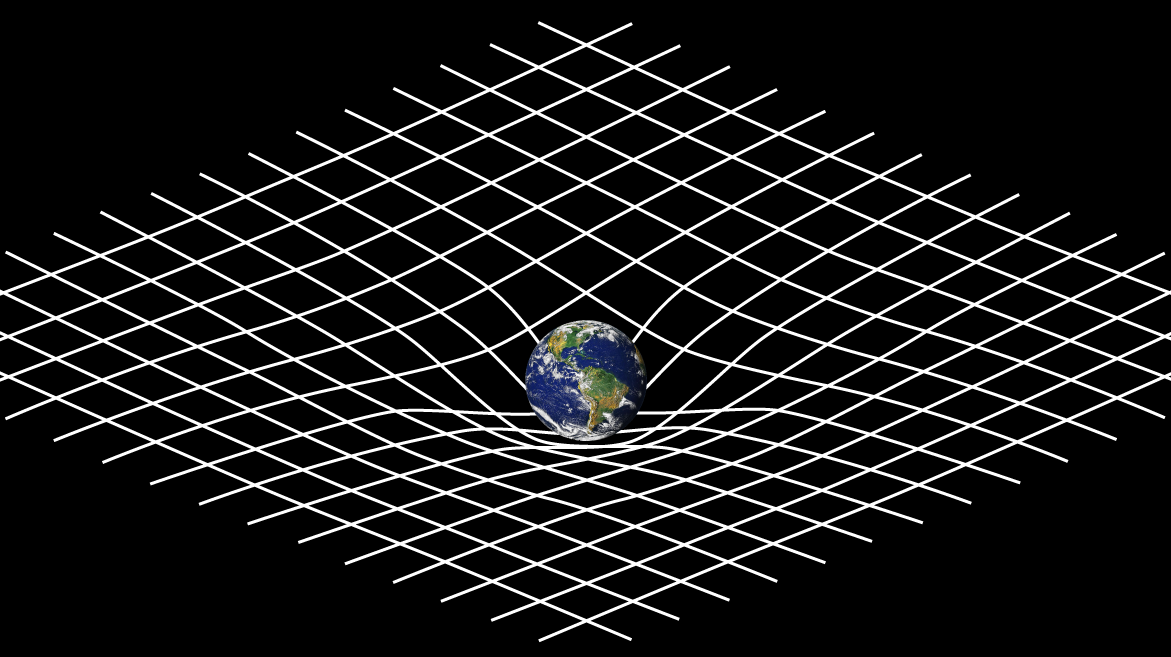
According to the general theory of relativity, gravity is not an actual force. A mass curves the space around it. For example, the Earth doesn't pull on the Moon to keep it close. Instead, the Moon stays in orbit around the Earth by following the curvature of space created by the Earth's mass. Credit: NASA
General relativity
The theory of general relativity makes a number of predictions about the influence of massive objects on the curvature of space. Many of those have already been extensively tested by observations. For example during a total solar eclipse, when you can see the starry sky during the day in the presence of the sun. Stars that are right next to the sun in the sky appear to have a slightly different position than the coordinates we assign them at night. The Sun’s mass curves the space around it, and therefore also the path of the starlight, making it seem to come from a different position. Another example is the phenomenon of gravitational lensing. Distant galaxies are sometimes visible in the shape of a ring, because their light does not only skim past a massive foreground object on the left, but due to curved space also on the right, above and below.
LISA will show us the way in a new dimension in the world of space curvature. Until now we’ve only seen the static curvature of relatively slow-moving objects. But gravitational waves offer a view of objects that are orbiting each other at furious speeds. LISA will be able to hear gravitational waves of celestial bodies that are pushing the limits of general relativity: supermassive black holes. Ground-based detectors LIGO and Virgo already do this to some extent with stellar black holes, but those emit much weaker waves. Did Einstein correctly predict even this extreme situation over a century ago? This concerns for example the structure of space right next to black holes. We can study it using LISA by listening to two merging supermassive black holes, or to the chaotic path of a star or stellar black hole when trapped in a deadly spiral towards a supermassive black hole.
